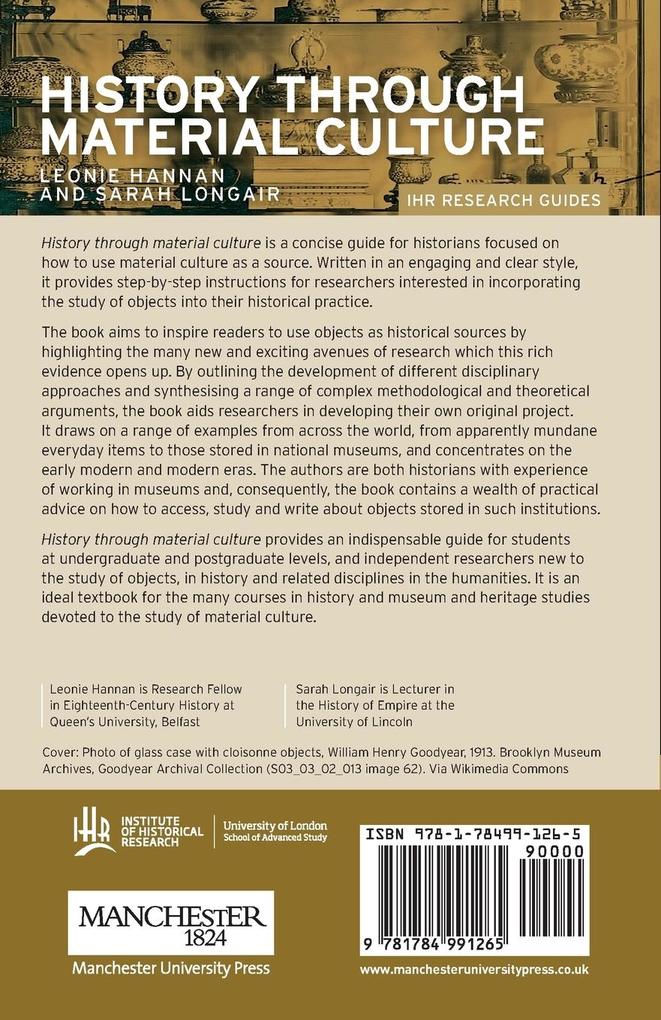
Zustellung: Mi, 09.07. - Sa, 12.07.
Versand in 5 Tagen
VersandkostenfreiBestellen & in Filiale abholen:
People live in material worlds and the things we make, wear, sit upon, treasure or discard are key to understanding our lives and societies. As material culture is central to human experience, it represents a vital but under-used source for historians. Written in a lively and accessible style, this new guide provides clear and practical guidance on how to incorporate the study of objects into historical practice.
History through material culture is a concise guide for historians focused on how to use material culture as a source. Written in an engaging and clear style, it provides step-by-step instructions for researchers interested in incorporating the study of objects into their historical practice.
The book aims to inspire readers to use objects as historical sources by highlighting the many new and exciting avenues of research which this rich evidence opens up. By outlining the development of different disciplinary approaches and synthesising a range of complex methodological and theoretical arguments, the book aids researchers in developing their own original project. It draws on a range of examples from across the world, from apparently mundane everyday items to those stored in national museums, and concentrates on the early modern and modern eras. The authors are both historians with experience of working in museums and, consequently, the book contains a wealth of practical advice on how to access, study and write about objects stored in such institutions.
History through material culture provides an indispensable guide for students at undergraduate and postgraduate levels, and independent researchers new to the study of objects, in history and related disciplines in the humanities. It is an ideal textbook for the many courses in history and museum and heritage studies devoted to the study of material culture.
The book aims to inspire readers to use objects as historical sources by highlighting the many new and exciting avenues of research which this rich evidence opens up. By outlining the development of different disciplinary approaches and synthesising a range of complex methodological and theoretical arguments, the book aids researchers in developing their own original project. It draws on a range of examples from across the world, from apparently mundane everyday items to those stored in national museums, and concentrates on the early modern and modern eras. The authors are both historians with experience of working in museums and, consequently, the book contains a wealth of practical advice on how to access, study and write about objects stored in such institutions.
History through material culture provides an indispensable guide for students at undergraduate and postgraduate levels, and independent researchers new to the study of objects, in history and related disciplines in the humanities. It is an ideal textbook for the many courses in history and museum and heritage studies devoted to the study of material culture.
Inhaltsverzeichnis
Introduction
1 Approaches to the material world
2 Planning a research project
3 Developing a methodology
4 Locating sources: understanding museum collections and other repositories
5 Analysing sources
6 Writing up findings
Afterword
Index
1 Approaches to the material world
2 Planning a research project
3 Developing a methodology
4 Locating sources: understanding museum collections and other repositories
5 Analysing sources
6 Writing up findings
Afterword
Index
Produktdetails
Erscheinungsdatum
18. April 2017
Sprache
englisch
Seitenanzahl
200
Autor/Autorin
Leonie Hannan, Sarah Longair
Verlag/Hersteller
Produktart
kartoniert
Gewicht
219 g
Größe (L/B/H)
198/129/11 mm
ISBN
9781784991265
Entdecken Sie mehr
Bewertungen
0 Bewertungen
Es wurden noch keine Bewertungen abgegeben. Schreiben Sie die erste Bewertung zu "History through material culture" und helfen Sie damit anderen bei der Kaufentscheidung.










